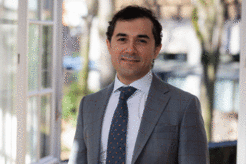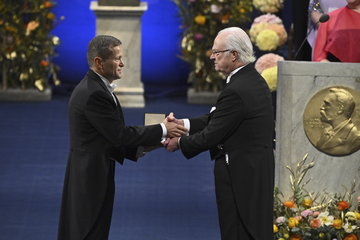“We will be using unique new Treuhand data”
Ufuk Akcigit, this year's winner of the Max Planck-Humboldt Research Award, explains the unique set-up of his Germany-based research project
30 years after the fall of the Berlin Wall, the economic gap between East and West Germany is still very large. In his research project, Max Planck-Humboldt Research Award winner and Professor of Economics at the University of Chicago, Ufuk Akcigit, will investigate the puzzling differences between the two sides of Germany – using a unique set of new data on the privatization in the former GDR.

Professor Akcigit, you are of Turkish descent, you have been working and living in the U.S. for many years. What attracts you about doing your research not just in, but also on Germany?
I have two answers to this question: When it comes to the economic situation of East and West Germany, we see a clear disconnect between what economic theory tells us and what we are observing in reality. Economies that are subject to similar conditions should converge to the same economic wellbeing in the long run, even though their initial condition might have been different. Yet, the two sides of Germany have not managed to do so – despite many attempts since its reunification. For me as a researcher, this is a very interesting puzzle and a unique set-up to study.
And your second answer?
I was born in Germany, but, unfortunately, we moved when I was five years old. Since then, Germany has always been part of my life, part of my culture. I have always been interested in both staying in touch with my German friends, but also learning more about the country in which I was born. That is why I am extremely happy that the Max Planck-Humboldt Research Award gives me the opportunity to intensify my ties with Germany.
Speaking of which: You will be working closely together with the Leibniz-Institut für Wirtschaftsforschung in Halle …

Yes, the IWH in Halle invited me several times in the past to give some talks. During my visits, I had the chance to interact with the local researchers at my future host institution. I was extremely impressed by the quality of their work, their excellent staff, their infrastructure – and: the unique data sources crucial for my project. Winning the Max Planck-Humboldt Research Award is a great opportunity to formalize our collaboration.
What will this cooperation look like?
We match perfectly: The Halle Institute’s roots lie with the transition from a central planning to a market economy in East Germany. Because of this focus, the Institute both has the resources as well as the data to support my research proposal. Using this research grant, I am going to build a team in Germany with about five to six researchers. In addition, there will be some local researchers from Halle Institute. We will investigate the microdata together and build new models and computer simulations that will mimic the German economy. There will be a very tight bridge between Halle and Chicago: I will spend some time in Halle myself, and I will also use the grant money to bring researchers to Chicago once in a while. At the same time, we will hold weekly online conferences. The team in Chicago and the team in Halle will meet online on a regular basis and discuss their weekly findings. I hope that we will become one very big research family.
You will investigate the causes of the economic gap between East and West Germany. From which angles will you tackle this question?
In general, my research is about understanding the drivers of innovation and technology. We typically attribute the long run differences across different economies to differences in technology and innovation. I will apply this approach to the unique set-up of the economic situation in Germany in three different sub-projects. When we compare the economic indicators in East and West Germany there is a very sizeable gap in pretty much everything that you look at: in terms of GDP per capita, income equality, how rapidly firms are growing, and in terms of the number of innovations per capita. And, of course, these are all interlinked. In my earlier research I found that equality, social mobility, growth of firms – they are all tightly linked to innovation.
You will be drawing on rich microdata in your research project. Could you share an example?
In general, I think it is extremely important to discuss policies based on microeconomic data instead of merely speculating. Thus, we will investigate in detail the differences in firm performance, for example the lifecycle of firms, using microdata: Whereas in West Germany, firms are growing very rapidly, and the ones that do not grow are exiting the economy, firms of the former GDR are not growing as rapidly. We will be doing an in-depth analysis trying to understand the incentives of the firms to grow or not grow. The second leg of my research will focus on understanding individuals through the lens of microdata. Because at the end of the day, these firms are not just some abstract entities. It is individuals who run them, who own them, who make decisions.
In one of your three sub-projects, you will be asking a pretty provocative question: “Did the privatization process in East Germany allocate the resources to the right “type” of entrepreneurs?” What do you mean by that?
Not everybody can become an artist. Not everybody can become an athlete. Likewise, not everybody can become an entrepreneur. It requires talent. That is why in healthy economies the resources are allocated to the most talented entrepreneurs. Obviously, there has been some interesting allocation of resources during the reunification by the Treuhand-Anstalt (THA) in the first half of the 1990s. How did this process of privatization take place? Were the resources allocated to the most effective and efficient entrepreneurs? Or, alternatively, has there been some other consideration by those in charge of the THA? The Treuhand data provides a great opportunity to do an in-depth-analysis of that period. The Halle Institute has access to the Treuhand data, the data from the Institute for Employment Research (IAB), and other historical data on firms and individuals at the time of the unification, which will allow us to study the long-term consequences of that massive privatization process.
Based on your preliminary findings: When will the economic gap between East and West Germany be overcome?
It would be too speculative to make such a prediction. In my preliminary analysis, I made an interesting observation though: Until the early 2000s, there had been some convergence between East and West Germany. Yet, suddenly this process slowed down. It is hard to predict ex ante why Germany suddenly stopped from converging. That’s why it’s hard to predict how long the productivity gap will remain. Clearly, the convergence will not take place unless the barriers are removed permanently. That’s why my research project aims at understanding what those frictions and barriers are.
What do you expect from your findings?
Every country, every economy has its own story. We cannot just simply look at the successful economies and adopt their policies, because in every economy the frictions are completely different. This also applies to Germany. Of course, Germany in general, and East Germany in particular, has its own challenges. That’s why, before designing policies, I think it is important to do a data-driven research. I am more than happy that the May Planck-Humboldt Research Award has been allocated to me for such efforts. Exciting times lie ahead of us in the next five years: Let the data speak now in order to promote data-driven policy-making in the future!
Interview: Petra Maaß














